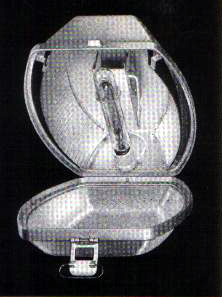|
Specification Clearmain 8401
Use
Main road lighting, especially roads in the vicinity of airfields. The lantern has a medium
angle beam distribution. Peak intensity occurs at 75 degrees, and at 80 degrees it is
two-thirds of the maximum value. The cut-off type of construction produces a rapid run back
over 80 degrees falling to a negligible figure at the horizontal. The lantern falls within the
specification issued by the Ministry Of Transport, whcih is reproduced on the back page.
Lanterns should be mounted at a height of 25 ft. and spaced not more than 120-130 ft.
apart. Suitable for road widths up to 50 ft.
Lamp
For use with a 250W or 400W Osram MA/V lamp.
Mounting
Top entry, standard tapping 1.1/4 in. B.S.P. The lantern can be provided with a device
to give levelling in any plane to a maximum of 5 degrees from the horizontal when
required with the M.O.T. specification overleaf.
Lantern Body
Totally enclosed die-cat aluminium-silicon alloy. The body carries the terminal block,
wiring, magnetic deflector, lampholder, lamp steady and the reflectors which make up the
optikon.
Lampholder
Porcelain G.E.S. wired with heat-resisting insulated wire to a porcelain terminal block.
Over-Reflector
Immediately above the lamp is a non-magnetic reflector. The reflector plate serves the
dual purpose of reflecting light and preventing rising hot air from overheating the magnetic
deflector.
Magnetic Deflector
The magnetic deflector enables an MA/V lamp burning horizontally to operate as efficiently
as it does in its normal perpendicular position. The deflector is mounted on the reflector
plate. It is connected in series with the lamp and consumes 1 watt. The magnetic deflector
can be used with either the 250W or 400W lamp, conversion from one wattage to the other
being made by changing a connection.
Optical System
Two curved glass mirrors are held inside the body to provide the light control.
All mirrors are first quality and are coppered, lead backed and secured by clips. A
die-cast light alloy frame, hinged to the body and secured by a stainless steel toggle
catch, supports a pressed heat-resisting glass dish.
Weathering Finish
The alloy used is especially selected for its resistance to corrosion and is processed to give
a pleasing appearance.
 |
| The lantern opened to show optical system, lamp mounting and over-reflector
carrying the magnetic deflector |

The iso-candela diagrams are based on an average lamp light output through life from
a 250W Osram MA/V lamp (8,750 lumens average).
| 250W | 400W |
| Directional intensity ratio | 3.1 | 2.6 |
| Light above horizontal | 2% | 2% |
| Light output ratio | 56% | 55% apprx |
| Lumens in the lower hemisphere | 3810 | 7080 |
Light distribution data are given for the guidance of the lighting engineer and represent the
average results of laboratory tests on a number of lanterns taken at random from stock.
The data are based on the lamp characteristics stated; if the latest lamp efficiency is different,
the candela or lumen values should be calculated in direct proportion to the relative lamp
lumens.
Lantern weight: 28lb (12.7 kg).
|



